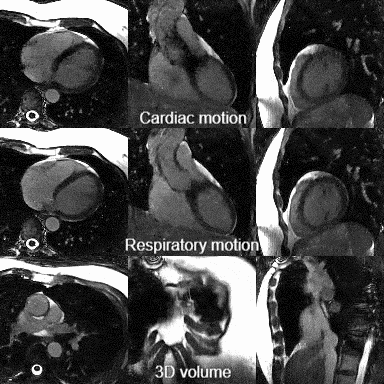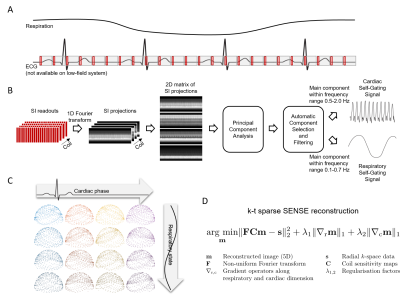Davide Piccini1,2, Jerome Yerly2,3, Tobias Kober1,2,4, Lorenzo Di Sopra2, Aurélien Bustin2,5,6, Daniel Giese7, Mario Bacher7, Michaela Schmidt7, Peter Speier7, Christian Geppert7, Rainer Schneider7, David Grodzki7, and Matthias Stuber2,3
1Advanced Clinical Imaging Technology, Siemens Healthcare AG, Lausanne, Switzerland, 2Department of Radiology, Lausanne University Hospital and University of Lausanne, Lausanne, Switzerland, 3CIBM Center for Biomedical Imaging, Lausanne, Switzerland, 4LTS5, École Polytechnique Fédérale de Lausanne (EPFL), Lausanne, Switzerland, 5IHU LIRYC, Electrophysiology and Heart Modeling Institute, Fondation Bordeaux Université, Pessac-Bordeaux, France, 6Department of Cardiovascular Imaging, Hôpital Cardiologique du Haut-Lévêque, CHU de Bordeaux, Pessac, France, 7Magnetic Resonance, Siemens Healthcare, Erlangen, Germany
1Advanced Clinical Imaging Technology, Siemens Healthcare AG, Lausanne, Switzerland, 2Department of Radiology, Lausanne University Hospital and University of Lausanne, Lausanne, Switzerland, 3CIBM Center for Biomedical Imaging, Lausanne, Switzerland, 4LTS5, École Polytechnique Fédérale de Lausanne (EPFL), Lausanne, Switzerland, 5IHU LIRYC, Electrophysiology and Heart Modeling Institute, Fondation Bordeaux Université, Pessac-Bordeaux, France, 6Department of Cardiovascular Imaging, Hôpital Cardiologique du Haut-Lévêque, CHU de Bordeaux, Pessac, France, 7Magnetic Resonance, Siemens Healthcare, Erlangen, Germany
The free-running framework (FRF) was successfully adapted to 0.55T and enabled free-breathing motion-resolved whole heart imaging without the need of any gating or triggering device while scan planning was reduced to a single mouse click.

Figure 5. Example of motion-resolved reconstruction of mid-resolution images acquired at 0.55T using the free-running framework: The final result from the FRF reconstruction shows how, using the physiological signals extracted from the data, both cardiac and respiratory motion are well resolved. The last row shows the large anatomical coverage provided by the 3D radial acquisition.

Figure 1. Free Running Framework: (A) Data were continuously acquired using a prototype 3D radial trajectory regardless of cardiac or respiratory motion. (B) The principal components of the SI readouts were analyzed and filtered to extract cardiac and respiratory self-gating signals. (C) The motion signals were used to sort the data into motion-consistent cardiac and respiratory phases. (D) The binned data were then reconstructed with a k-t sparse SENSE algorithm that exploits data redundancy among the different bins followed by a high-dimensionality patch-based denoising.
